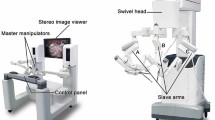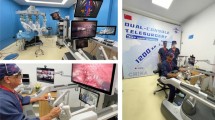Abstract
Background
Network latency is the most important factor affecting the performance of telemedicine. The aim of the study is to assess the feasibility and efficacy of a novel network latency management system in 5G telesurgery.
Methods
We conducted 20 telesurgery simulation trials (hitching rings to columns) and 15 remote adrenalectomy procedures in the 5G network environment. Telemedicine Network Latency Management System and the traditional "Ping command" method (gold standard) were used to monitor network latency during preoperative simulated telesurgery and formal telesurgery. We observed the working status of the Telemedicine Network Latency Management System and calculated the difference between the network latency data and packet loss rate detected by the two methods. In addition, due to the lower latency of the 5G network, we tested the alert function of the system using the 4G network with relatively high network latency.
Results
The Telemedicine Network Latency Management System showed no instability during telesurgery simulation trials and formal telesurgery. After 20 telesurgery simulation trials and 15 remote adrenalectomy procedures, the p-value for the difference between the network latency data monitored by the Telemedicine Network Latency Management System and the "Ping command" method was greater than 0.05 in each case. Meanwhile, the surgeons reported that the Telemedicine Network Latency Management System had a friendly interface and was easy to operate. Besides, when the network latency exceeded a set threshold, a rapid alarm sounded in the system.
Conclusion
The Telemedicine Network Latency Management System was simple and easy to operate, and it was feasible and effective to use it to monitor network latency in telesurgery. The system had an intuitive and concise interface, and its alarm function increased the safety of telesurgery. The system's own multidimensional working ability and information storage capacity will be more suitable for telemedicine work.




Similar content being viewed by others
Change history
02 February 2024
A Correction to this paper has been published: https://doi.org/10.1007/s00464-024-10712-2
References
Marescaux J et al (2001) Transatlantic robot-assisted telesurgery. Nature 413(6854):379–380
Nguan C, Miller B, Patel R et al (2008) Pre-clinical remote telesurgery trial of a da Vinci telesurgery prototype. Int J Med Robot 4(4):304–309
Sterbis JR, Hanly EJ, Herman BC et al (2008) Transcontinental telesurgical nephrectomy using the da Vinci robot in a porcine model. Urology 71(5):971–973
Hung AJ, Chen J, Shah A et al (2018) Telementoring and telesurgery for minimally invasive procedures. J Urol 199(2):355–369
Jin ML, Brown MM, Patwa D et al (2021) Telemedicine, telementoring, and telesurgery for surgical practices. Curr Probl Surg 58(12):100986
Xia SB, Lu QS (2021) Development status of telesurgery robotic system. Chin J Traumatol 24(3):144–147
Perez M, Xu S, Chauhan S et al (2016) Impact of delay on telesurgical performance: study on the robotic simulator dV-Trainer. Int J Comput Assist Radiol Surg 11(4):581–587
Xu S, Perez M, Yang K et al (2014) Determination of the latency effects on surgical performance and the acceptable latency levels in telesurgery using the dV-Trainer((R)) simulator. Surg Endosc 28(9):2569–2576
Zheng J, Wang Y, Zhang J et al (2020) 5G ultra-remote robot-assisted laparoscopic surgery in China. Surg Endosc 34(11):5172–5180
Yi B et al (2016) The first clinical use of domestically produced Chinese minimally invasive surgical robot system “MicroHand S.” Surg Endosc 30(6):2649–2655
Yi B et al (2017) Domestically produced Chinese minimally invasive surgical robot system “MicroHand S” is applied to clinical surgery preliminarily in China. Surg Endosc 31(1):487–493
Li J, Jiao W, Yuan H et al (2022) Telerobot-assisted laparoscopic adrenalectomy: feasibility study. Br J Surg 110:6–9
Sachdeva N, Klopukh M, Clair RS, Hahn WE (2021) Using conditional generative adversarial networks to reduce the effects of latency in robotic telesurgery. J Robot Surg 15(4):635–641
Madder RD, VanOosterhout S, Mulder A et al (2020) Network latency and long-distance robotic telestenting: exploring the potential impact of network delays on telestenting performance. Catheter Cardiovasc Interv 95(5):914–919
Barba P, Stramiello J, Funk EK et al (2022) Remote telesurgery in humans: a systematic review. Surg Endosc 36(5):2771–2777
Li J et al (2023) Application of improved robot-assisted laparoscopic telesurgery with 5G technology in urology. Eur Urol 83(1):41–44
Lu ES, Reppucci VS, Houston SKS 3rd et al (2021) Three-dimensional telesurgery and remote proctoring over a 5G network. Digit J Ophthalmol 27(3):38–43
Mohan A, Wara UU, Arshad Shaikh MT et al (2021) Telesurgery and robotics: an improved and efficient era. Cureus 13(3):e14124
Acknowledgements
This work was supported by National Natural Science Foundation of China (52122501), Major Scientific and Technological Innovation Project of Shandong Province (2019JZZY021002), Taishan Scholar Program of Shandong Province (tsqn20221165), and Qingdao People’s Life Science and Technology Project (18-6-1-64-nsh).
Author information
Authors and Affiliations
Contributions
HN designed the research; LL, WJ, HY, and CX assisted the telesurgeries; JD, HG, YH, and ZG collected the data; LJ, JC, ZZ, CZ, and LZ analyzed the data; LJ and JC wrote the manuscript; DG, FQ, CJ, MJ, XZ, and HN edited the manuscript; all authors reviewed and approved the manuscript.
Corresponding authors
Ethics declarations
Disclosures
Jilu Zheng, Chengjun Li, Lei Luo, Guangdi Chu, Jianchang Zhao, Zhao Zhang, Haiyun Wang, Fei Qin, Guanzhi Zhou, Jianmin Li, Wei Jiao, Yonghua Wang, Xuecheng Yang, Zhilong Zhou, Dejun Yang, Hao Guo, Ce Zhang, Xin Zhang and Haitao Niu declare that they have no conflict of interests to disclose.
Ethical approval
The telesurgery was ratified by the Ethics Boards of all hospitals and was registered at ClinicalTrials.gov (NCT04804163). Written informed consent was signed by all patients. We didn’t encounter significant intraoperative hemorrhage or robot breakdown, but we were prepared to convert to standard laparoscopic surgery or open surgery to ensure safety, if needed.
Additional information
Publisher's Note
Springer Nature remains neutral with regard to jurisdictional claims in published maps and institutional affiliations.
The original online version of this article was revised due to a retrospective Open Access cancellation.
Supplementary Information
Below is the link to the electronic supplementary material.
Electronic supplementary material 2 (MP4 3063 kb)
Electronic supplementary material 3 (MP4 10521 kb)
Rights and permissions
Springer Nature or its licensor (e.g. a society or other partner) holds exclusive rights to this article under a publishing agreement with the author(s) or other rightsholder(s); author self-archiving of the accepted manuscript version of this article is solely governed by the terms of such publishing agreement and applicable law.
About this article
Cite this article
Li, C., Zheng, J., Zhang, X. et al. Telemedicine network latency management system in 5G telesurgery: a feasibility and effectiveness study. Surg Endosc 38, 1592–1599 (2024). https://doi.org/10.1007/s00464-023-10585-x
Received:
Accepted:
Published:
Issue Date:
DOI: https://doi.org/10.1007/s00464-023-10585-x




